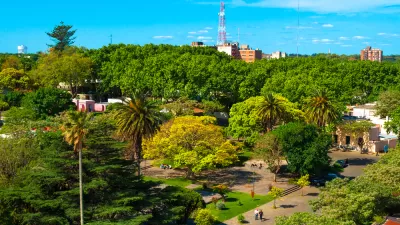Imagine converting a downtown street into a bicycle, people, and eco-friendly one - for just one week, by a crack team of urban design graduate students. Such an undertaking was done by Kent State U.'s urban design collaborative. Watch and learn!
The video below describing the one-week conversion of Rockwell Ave using "pop-up cycling infrastructure" is narrated by:
- David Jurca, Kent State's Urban Design instructor, who describes the overall project;
- Jenita McGowan, Cleveland Sustainability Chief, who defines a complete street as well as a green one;
- Rachel Webb, Regional Sewer District, on green streets;
- Robert Mason of U.S. Homeland Security who discusses crime prevention through environmental design, aka CPTED, bringing an important dimension to streets - "does it feel safe" (for a pedestrian);
- Marty Cader, Cleveland's Bicycle and Pedestrian Coordinator, who provides the background of Cleveland's transportation infrastructure and the suitability of Rockwell Street and and the one-week trial;
- Jennifer Coleman, Cleveland Landmark Commissions Chair, who describes how the project has brought more life to the street; and
- a Bike Cleveland spokesman who advocates for permanent solutions that the trial demonstrated.
Jurca suggests that future pop-up projects last longer than one week in order to get better feedback from the public.
Thanks to Streetsblog
FULL STORY: Cleveland: Building Public Support With Pop-up Cycling Infrastructure

Planetizen Federal Action Tracker
A weekly monitor of how Trump’s orders and actions are impacting planners and planning in America.

Maui's Vacation Rental Debate Turns Ugly
Verbal attacks, misinformation campaigns and fistfights plague a high-stakes debate to convert thousands of vacation rentals into long-term housing.

Restaurant Patios Were a Pandemic Win — Why Were They so Hard to Keep?
Social distancing requirements and changes in travel patterns prompted cities to pilot new uses for street and sidewalk space. Then it got complicated.

In California Battle of Housing vs. Environment, Housing Just Won
A new state law significantly limits the power of CEQA, an environmental review law that served as a powerful tool for blocking new development.

Boulder Eliminates Parking Minimums Citywide
Officials estimate the cost of building a single underground parking space at up to $100,000.

Orange County, Florida Adopts Largest US “Sprawl Repair” Code
The ‘Orange Code’ seeks to rectify decades of sprawl-inducing, car-oriented development.
Urban Design for Planners 1: Software Tools
This six-course series explores essential urban design concepts using open source software and equips planners with the tools they need to participate fully in the urban design process.
Planning for Universal Design
Learn the tools for implementing Universal Design in planning regulations.
Heyer Gruel & Associates PA
JM Goldson LLC
Custer County Colorado
City of Camden Redevelopment Agency
City of Astoria
Transportation Research & Education Center (TREC) at Portland State University
Jefferson Parish Government
Camden Redevelopment Agency
City of Claremont




























